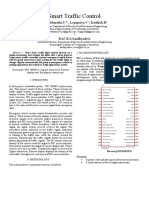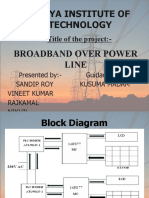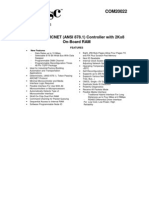ARDUINO BASED WIRELESS ELECTRONIC NOTICE BOARD USING GSM MODEM Ijariie13835
ARDUINO BASED WIRELESS ELECTRONIC NOTICE BOARD USING GSM MODEM Ijariie13835
Uploaded by
Faran JeeCopyright:
Available Formats
ARDUINO BASED WIRELESS ELECTRONIC NOTICE BOARD USING GSM MODEM Ijariie13835
ARDUINO BASED WIRELESS ELECTRONIC NOTICE BOARD USING GSM MODEM Ijariie13835
Uploaded by
Faran JeeOriginal Description:
Original Title
Copyright
Available Formats
Share this document
Did you find this document useful?
Is this content inappropriate?
Copyright:
Available Formats
ARDUINO BASED WIRELESS ELECTRONIC NOTICE BOARD USING GSM MODEM Ijariie13835
ARDUINO BASED WIRELESS ELECTRONIC NOTICE BOARD USING GSM MODEM Ijariie13835
Uploaded by
Faran JeeCopyright:
Available Formats
Vol-7 Issue-2 2021 IJARIIE-ISSN(O)-2395-4396
ARDUINO BASED WIRELESS ELECTRONIC
NOTICE BOARD USING GSM MODEM
E.S.Priyadharshini, T.Saranya* M.Sona, K.Jenifer Asuntha, G.Umamaheshwari, R.Nisha,
Department of Physics, Kamban Arts & Science College for Women, Tiruvannamalai-606603,
Tamilnadu. India.
Abstract
The GSM based control system implements the emerging applications of the global system for mobile
communication technology.The microcontroller will control the system by using the programming commands and
the message will be display on the LCD.In the last of decodes,communication technology has developed by leaps
and bounds.In our day-to-day life,we use many such appliances at home,office,and public places for our comfort a
convenience. The use of Embedded system in communication has given rise to many interesting application GSM
based control system implements the emerging application of the global system for mobile communication. so,by
adding wireless communication interface such GSM to these systems,we can overcome their limitations.
Keywords: LCD; SIM Card; Microcontroller
1. INTRODUCTION
The Global system for mobile communication technology was developed in the year 1970.The GSM based are also
called campus display system (CDS). 7×5(5 segment display)light emitting diodes display interfaced to the dot
matrix controller which converts instructions from a processor in the signal which turns ON or OFF lights in the
matrix so that the required display is produced. GSM are used at other public place like schools, hospital, railway
stations, garden etc., without affecting the surrounding environment. The notice board is the most important thing in
any institution organized but changing different notice day by day is difficult process and consumes more time to
overcome these problems here, is a project which deals with an innovative wireless notice board. The main concept
of this project is to design a wireless notice board that display various notices sent from the mobile phone. It is
further display interfaced to microprocessor powered by a regulated power supply from mains supply of 230 volts
ac. [1] In this modern world mobile phones and the related technologies are becoming more prevalent. Various
technical area in the field of telecommunication and embedded system and becoming omnipresent in the people.[2]
2.WORKING OF MATERIALS:
2.1. Components:
Microcontroller(8051-IC), GSM Modem, LCD (Liquid Crystal Display) and Arduino nano, SCR, pot, battery.
8051 has 8bit ALU which can perform all the 8-bit arithmetic and logical operations in one machine
cycle.GSM can accept any network operator SIM card and card act just like a mobile phone with its own unique
phone number.LCD (liquid crystal display) is an electronic device for displaying text or characters.
13835 www.ijariie.com 296
Vol-7 Issue-2 2021 IJARIIE-ISSN(O)-2395-4396
Fig.1 Block diagram of the GSM modem
GSM is combination of TDMA (Time Division Multiple Access), FDMAC (Frequency Division Multiple Access)
and frequency hopping.The message received is thus sent to the 8051 microcontrollers. furthermore, that display it
on a wireless notice board which is in built with an LCD display. Here LCD display is interfaced with an 8051
microcontroller which is duly powered by an RPS (regulated power supply) from a 230V AC mains supply as
shown in fig.1.
Furthermore, designing of this wireless notice board project can be enhanced by providing a message storage facility
by EEPROM (NON- VOLATILE MEMORY). This EEPROM is attached to the 8051 microcontrollers for the
recovery of old message if needed.
2.2. HARDWARE:
1.Power supply
2. Microcontroller (LPC2148)
3. GSM
4.LCD Board
2.2.1. power supply
AC mains electricity to asuitable low voltage supply for electronic circuits and other devices. A D.C power supply
which maintains the output voltage constantirrespective of act mains fluctuations or load variations is known as
“Regulated D.C power supply” The power supply is designed to convert high voltage
2.2.2. Microcontroller
Microcontroller (LPC 2148) ARM stands for Advanced RISC Machines. It is a 32-bit processor core, used for high
end application. It is widely used in Advanced Robotic Applications.The above circuit of the wireless electronic
notice boards using GSM consists of 8051 microcontroller GSM MODULE (MODEM).[3]
Key features:
● 16-bit/32-bit ARM7TDMI-S microcontroller in a tiny LQFP64 package.
13835 www.ijariie.com 297
Vol-7 Issue-2 2021 IJARIIE-ISSN(O)-2395-4396
● 8 kB to 40 kB of on-chip static RAM and 32 kB to 512 kB of on-chip flash memory.
● 128-bit wide interface/accelerator enables high-speed 60 MHz operation.
● In-System Programming/In-Application Programming (ISP/IAP) via on-chip boot loader software. Single flash
sector or full chip erase
● tracing of instruction execution.
● USB 2.0 Full-speed compliant device controller with 2 kB of endpoint RAM.
● In addition, the LPC2146/48 provides 8 kB of on-chip RAM accessible to USB by DMA.
● One or two (LPC2141/42 vs. LPC2144/46/48) 10-bit ADCs provide a total of 6/14 analog inputs, with conversion
times as low as 2.44 as per channel.
● Single 10-bit DAC provides variable analog output (LPC2142/44/46/48 only).
● Two 32-bit timers/external event counters (with four capture and four compare channels each), PWM unit (six
outputs) and watchdog.
● Low power Real-Time Clock (RTC) with independent power and 32 kHz clock input.
● Multiple serial interfaces including two UARTs (16C550), two Fast I2C-bus (400 kbit/s),
● SPI and SSP with buffering and variable data length capabilities.
● Vectored Interrupt Controller (VIC) with configurable priorities and vector addresses.
● Up to 45 of 5 V tolerant fast general purpose I/O pins in a tiny LQFP64 package.
● Up to 21 external interrupt pins available.
● 60 MHz maximum CPU clock available from programmable on-chip PLL with settling time of 100 as.
● On-chip integrated oscillator operates with an external crystal from 1 MHz to 25 MHz
● Power saving modes include Idle and Power-down.
Fig.2 NXP LPC2148 Microcontroller
13835 www.ijariie.com 298
Vol-7 Issue-2 2021 IJARIIE-ISSN(O)-2395-4396
2.2.3. GSM Modem
This is a GSM/GPRS-compatible Quad-band cell phone, which works on a frequency of
850/900/1800/1900MHz and which can be used not only to access the Internet, but also for oral communication
(provided that it is connected to a microphone and a small loud speaker) and for SMSs. Externally, it looks like a big
package (0.94 inches x 0.94 inches x 0.12 inches) with L-shaped contacts on four sides so that they can be soldered
both on the side and at the bottom. Internally, the module is managed by an AMR926EJ-S processor, which controls
phonecommunication, data communication (through an integrated TCP/IP stack), and (through an UART and a TTL
serial interface) the communication with the circuit interfaced with the cell phone itself as shown in fig.3. The
processor is also in charge of a SIM card (3 or 1,8 V) which needs to be attached to the outer wall of the module. [4]
Fig.3 GSM Modem
Features
-Uses the extremely popular SIM900 GSM module
-Provides the industry standard serial RS232 interface for easy connection to computers and other devices
-Provides serial TTL interface for easy and direct interface to Microcontrollers -Optionally available USB interface
for easy interface to laptops, computers, etc.,
-Onboard MIC and Speaker circuits and 3.5mm audio connectors for direct connection to mics and speaker
-All pins of the SIM900 module can be tapped into for expansion using onboard expansion holes. GPIO pins, Serial
communication pins, 2 PWM pins, I2C pins and ADC pins are broken out to standard 0.1” spaced holes for easy
expansion -Power, Status and Network LEDs for easy debugging
-Can be used for GSM based Voice communications, Data/Fax, SMS, GPRS and TCP/IP stack -Can be controlled
through standard AT commands 36
-Module’s operation mode can be controlled through the PWR Key connected to the PWRKEY pin (refer the
SIM900 datasheet for more information)
-Comes with an onboard wire antenna for better reception. Board provides an option for adding an external antenna
through an SMA connector
-The SIM900 allows an adjustable serial baud rate from 1200 to 115200 bps (autobaud by default) -Modem a low
power consumption of 0.25 A during normal operations and around 1 A during transmission
-Operating Voltage: 7 – 15V AC or DC (board has onboard rectifier)
13835 www.ijariie.com 299
Vol-7 Issue-2 2021 IJARIIE-ISSN(O)-2395-4396
2.2.4. LCD Board
Liquid crystal displays (LCDs) have materials, which combine the properties of both liquids and crystals.
Rather than having a melting point, they have a temperature range within which the molecules are almost as mobile
as they would be in a liquid, but are grouped together in an ordered form similar to a crystal.
An LCD consists of two glass panels, with the liquid crystal material sand witched in between them. The
inner surface of the glass plates is coated with transparent electrodes which define the character, symbols or patterns
to be displayed polymeric layers are present in between the electrodes and the liquid crystal, which makes the liquid
crystal molecules to maintain a defined orientation angle.
One each polarizer is pasted outside the two glass panels. These polarizers would rotate the light rays passing
through them to a definite angle, in a particular direction. When the LCD is in the off state, light rays are rotated by
the two polarizers and the liquid crystal, such that the light rays come out of the LCD without any orientation, and
hence the LCD appears transparent.
When sufficient voltage is applied to the electrodes, the liquid crystal molecules would be aligned in a
specific direction. The light rays passing through the LCD would be rotated by the polarizers, which would result in
activating/ highlighting the desired characters. The LCD’s are lightweight with only a few millimeters thickness.
Since the LCD’s consume less power, they are compatible with were electroniccircuits, and can be powered for long
durations.
The LCD’s don’t generate light and so light is needed to read the display. By using backlighting, reading is possible
in the dark. The LCD’s have long life and a wide operating temperature range. The LCDs used exclusively in
watches, calculators and measuring instruments are the simple seven-segment displays, having a limited amount of
numeric data. The recent advances 23 in technology have resulted in better legibility, more information displaying
capability and a wider temperature range. These have resulted in the LCDs being extensively used in
telecommunications and entertainment electronics. The LCDs have even started replacing the cathode ray tubes
(CRTs) used for the display of text and graphics, and also in smallTVapplications.
Fig. 4 LCD interfacing with 8051
LCD Operation
In recent years the LCD is finding widespread use replacing LEDs (seven-segment LEDs or other multi-segment
LEDs). This is due to the following reasons. [2]
1. The declining prices of LCDs.
13835 www.ijariie.com 300
Vol-7 Issue-2 2021 IJARIIE-ISSN(O)-2395-4396
2. The ability to display numbers, characters and graphics. This is in contract to LEDs, which are limited to
numbers and a few characters. Light is produced when the particles that carry the current (know as electrons and
holes) combine together within the semiconductor material.[6]
3. Incorporation of a refreshing controller into the LCD, there by relieving the CPU of the task of refreshing the
LCD. In the contrast, the LED must be refreshed by the CPU to keep displaying the data.
4. Ease of programming for characters and graphics.
Uses
The LCDs used exclusively in watches, calculators and measuring instruments are the simple seven-segment
displays, having a limited amount of numeric data. The recent advances in technology have resulted in better
eligibilities wireless communication is designed for audience for audience working in the communications and
networking communities.[5] The more information displaying capability and a wider temperature range. These have
resulted in the LCDs being extensively used in telecommunications and entertainment electronics. The LCDs have
even started replacing the cathode ray tubes (CRTs) used for the display of text and graphics, and also in small TV
applications.
3. SOFTWARE:
Embedded set of language extensions form the c programming language by the c standards committee to address
commonality issues that exist between c extensions for different embedded systems.such ass fixed -point arithmetic,
multiple distinct memory banks,distinct memory banks, and basic operations as shown fig 5.
Fig.5 LCD Operation
4. APPLICATIONS:
Education Institutions and organizations: currently we rely on putting up papers on notice boards to notice to inform
people of events. This method can be discarded by using wireless notice boards to display information in real time
[8]
Advertisement: In shopping malls we get to hear the offers on various products from time to time.Instead, we
continuously display the information regarding the products and related offers on electronic display boards.
Railway station: Instead of announcing the delay in arrival of trains we can display the information.
13835 www.ijariie.com 301
Vol-7 Issue-2 2021 IJARIIE-ISSN(O)-2395-4396
4.1. MERITS:
User friendly: Messages are only to be typed on a mobile or a computer, which in turn are displayed wirelessly on
the display unit.
Eliminate use of printers: since we don’t use papers to display information, printers are also of use in this system.
Long range: As long as we have the requirement network coverage we can from any part of the world.
PROGRAM:
int pot = A7;
const int ENA = 6;
void setup ()
{
pin Mode (A7, INPUT);
Serial. Begin (9600);
pin Mode (ENB, OUTPUT);
}
void loop ()
{
//int pwm = analogRead(pot);
//Serial.println(pwm);
//pwm = map(pwm,1,1023,1,255);
//Serial Print
//Control Speed
analogWrite(ENB, 200);
5. RESULT AND DISCUSSION:
A commercial model should be able to display more than one message at a time currently in this project
we are using on board RAM memory to save a single message. The uses of microcontroller in a place of general-
purpose computer allows us to theorize on many further improvements on this project prototype the message is
board cast by the mobile switching centre for a continuous time period during which as a many possible display
board MODEMS catch the message and display it as per the constrains of validation. Using the principle of AT
commands, we can put ON or OFF this appliance remotely
13835 www.ijariie.com 302
Vol-7 Issue-2 2021 IJARIIE-ISSN(O)-2395-4396
Fig.6 Explaining the circuit
6. CONCLUSION:
This project is remote notice board with modem connected to it, so if the user wants to display some messages, he
will send the messages in SMS format. The SMS is deleted from the SIM each time it is read, thus making room for
the next SMS. This project can be used mainly for police or army to display something crucial within a matter of
seconds so keeping mind we are designing a new display system. We can access remotely, thus utilizing GSM
technology. In this case it solves the problem of instant information transfer in the campus.
REFERNCES:
[1]. Display message on notice board using gsm”, Advanced in Electronic Engineering, Vol. 3, no. 7, PP. 827,
2013.F. Kamdari, A. Malhotra, and P. Mahadik, “
[2]. Hardik Gupta, Pooja Shukla, Ankita Nagwekar “GSMbased LED scrolling display “. International Journal
of Students Research in Technology and Management, vol.3, may 2013, ISBN [978-93-83006-01-4], pg
278-291.
[3]. Jagan Mohan Reddy, Venkareshwarlu “wirelesselectronic display board using GSM technology”,
International Journal of Electrical, Electronics and Data communication. ISSN :2320-2084, volume- Dec
2013,1, Issue-10,
[4]. Foram Kamdar. AnubbhavMalhotra,PritishMahadik “Display Message on Notice Board using GSM”,
Advanced
[5]. Electronics and Electric Engineering. ISSN 2231-1297, Volume 3, Number 7 (2013), pp.827-832 Research
India
[6]. [5] Andera Goldsmith (2012); “wireless Communication” IEEE journal on communication,
www.iee.org,Vol. 2, no.4.
[7]. A. Mujumdar, V. Niranjana, and sagne, “Scrolling led display using wireless transmission”, International
journal of engineering Development and Research, Vol.2, no. 10, pp. 475-478, 2014
13835 www.ijariie.com 303
Vol-7 Issue-2 2021 IJARIIE-ISSN(O)-2395-4396
[8]. A.M. Sarma, N.S. Raju, B.D. Prasad, B.V. Satyanarayana, and N. P. Kumar, “A basic research on gsm
based secured advertising system,” Journal of information, knowledge and Research in Electronic and
Communication, vol, 2, pp.933- 936, 2013.
[9]. B. Soini, R. Devi, S. Haque, and J. Karu, “Smart led display boards,” International journal of electronic
engineering, vol,7, no. 10, pp. 1057-1067,2014.
[10]. J. Komal, S. sana, s. Swapnil, B. Jasmin, and R.N. Mahind, “Android based college notification system”
International Research Journal of engineering and Technology (IRJET), vol 3, no.3, pp.1768-1770,2016.
[11]. A. Meenachi, S. Kowsalya, and p.p. Kumar, “wireless e-notice board using wi-fi and Bluetooth
technology,” journal of network communication and Emerging Technologies (JNCET), VOL.6, no.pp.14-
20, 2016.
13835 www.ijariie.com 304
You might also like
- I Have No Mouth and I Must Scream - Manual PDFDocument20 pagesI Have No Mouth and I Must Scream - Manual PDFanton eNo ratings yet
- SCD5200 Dual Communications ModulesDocument8 pagesSCD5200 Dual Communications ModulesWisnu HartonoNo ratings yet
- 8×8 LED Matrix MAX7219 With Scrolling Text & Android Control Via BluetoothDocument15 pages8×8 LED Matrix MAX7219 With Scrolling Text & Android Control Via BluetoothakashlogicNo ratings yet
- ChainlinkDocument15 pagesChainlinkPhillip James TanNo ratings yet
- S1 Agile - Release Notes 2.1.3Document3 pagesS1 Agile - Release Notes 2.1.3Cjdavies49No ratings yet
- Paper By:: Thunuguntla Gayathri Vusthepalli SravaniDocument7 pagesPaper By:: Thunuguntla Gayathri Vusthepalli SravaniNaga Neelima ThunuguntlaNo ratings yet
- Wireless GSM Based Electronic Notice BoardDocument7 pagesWireless GSM Based Electronic Notice BoardNagendramataNo ratings yet
- Remote Notice Board Using GSM With SmsDocument14 pagesRemote Notice Board Using GSM With SmsMikroc Thupati SrinivsNo ratings yet
- ARM Question Bank Unit - 5Document14 pagesARM Question Bank Unit - 5sakthivelv.eecNo ratings yet
- Secure Data CommunicationDocument11 pagesSecure Data CommunicationNeela ChennurNo ratings yet
- 25.ACCESSIBLE DISPLAY DESIGN TO CONTROL HOME AREA NETWORKSDocumentDocument84 pages25.ACCESSIBLE DISPLAY DESIGN TO CONTROL HOME AREA NETWORKSDocumentdileeppatraNo ratings yet
- GSM Based Led Scrolling Display Board PDFDocument14 pagesGSM Based Led Scrolling Display Board PDFsabNo ratings yet
- (FALL 2007) : Bs Electronics Engineering Final Year Project ProposalDocument9 pages(FALL 2007) : Bs Electronics Engineering Final Year Project Proposalarif_khan07100% (1)
- Smart Traffic Control: Divyabharathi.S, Logapriya.V, Karthick.RDocument6 pagesSmart Traffic Control: Divyabharathi.S, Logapriya.V, Karthick.RLogapriya ViswanathanNo ratings yet
- Report For Automatic Power Meter Reading Using GSMDocument22 pagesReport For Automatic Power Meter Reading Using GSM9421568904No ratings yet
- Gsm-Gps Vehicle Theft Control SystemDocument78 pagesGsm-Gps Vehicle Theft Control SystemMrunalini Spandana100% (1)
- GSM Based Led Dot-Matrix Message Display: Vishvendra Pal Singh NagarDocument8 pagesGSM Based Led Dot-Matrix Message Display: Vishvendra Pal Singh Nagararul selvanNo ratings yet
- Rfid Access Control System and Security WebcamDocument6 pagesRfid Access Control System and Security WebcamAjay BhaleraoNo ratings yet
- Assignment Set I (1) UpdateDocument15 pagesAssignment Set I (1) UpdateAshish OjhaNo ratings yet
- Multiuser Short Message Service Based Wireless Electronic Notice BoardDocument7 pagesMultiuser Short Message Service Based Wireless Electronic Notice BoardPavanJangidNo ratings yet
- Alcatel-Lucent 9926 Digital 2U ENode B Product DatasheetDocument2 pagesAlcatel-Lucent 9926 Digital 2U ENode B Product Datasheetsmartem100% (1)
- Remote Notice Board Using GSM With SmsDocument7 pagesRemote Notice Board Using GSM With SmsMini KandregulaNo ratings yet
- MR - Gajanan Birajdar: Wireless Electronic Notice Board Using GSMDocument9 pagesMR - Gajanan Birajdar: Wireless Electronic Notice Board Using GSMVishalNo ratings yet
- GSM Based Home AutomationDocument64 pagesGSM Based Home AutomationVishwajith Singh100% (3)
- Railway Gate Control ARDUINODocument21 pagesRailway Gate Control ARDUINOAbdul RazzakNo ratings yet
- 1stphasegsm 120809075739 Phpapp02Document21 pages1stphasegsm 120809075739 Phpapp02Krish KarnNo ratings yet
- ECG Holter RecorderDocument12 pagesECG Holter RecorderAmalesh RaviNo ratings yet
- ATM Terminal Design Based On Figure Print Recognition DocuDocument115 pagesATM Terminal Design Based On Figure Print Recognition DocuPraveen NaiduNo ratings yet
- Bajaj Institute of Techhnology, WardhaDocument14 pagesBajaj Institute of Techhnology, WardhaSandesh JidewarNo ratings yet
- FM Based Long Range Remote Control: Project Work ONDocument42 pagesFM Based Long Range Remote Control: Project Work ONVenkatesh DoppalapudiNo ratings yet
- Vehicle Speed Control Using R.F. Technology: 1 Project Report OnDocument57 pagesVehicle Speed Control Using R.F. Technology: 1 Project Report OnAvinash RanjanNo ratings yet
- Project Introductive Seminar OnDocument26 pagesProject Introductive Seminar OnDarshanNo ratings yet
- Traffic LightDocument18 pagesTraffic LightHarish KhanNo ratings yet
- Power Theft Detection Using Wireless System-LibreDocument7 pagesPower Theft Detection Using Wireless System-LibreEnvisage123No ratings yet
- Solar Panel Monitoring System Using GSMDocument7 pagesSolar Panel Monitoring System Using GSMBaliom AbaNo ratings yet
- Design and Implementation of RF Deployed SMS Based Equipment ControllerDocument4 pagesDesign and Implementation of RF Deployed SMS Based Equipment ControllerThanhha NguyenNo ratings yet
- ROBOTCONTROLDocument83 pagesROBOTCONTROLAnkhina KaushikNo ratings yet
- ReportDocument45 pagesReportdadycoolNo ratings yet
- A Project Report: in Partial Fulfillment For The Award of The DegreeofDocument26 pagesA Project Report: in Partial Fulfillment For The Award of The DegreeofPujaNo ratings yet
- Microcontroller (AT89S52) Based Remote Notice Board Using GSMDocument72 pagesMicrocontroller (AT89S52) Based Remote Notice Board Using GSMAkshayNo ratings yet
- Design of A Wireless Medical Monitoring System: Computer and Management (CAMAN), 2011 International Conference OnDocument8 pagesDesign of A Wireless Medical Monitoring System: Computer and Management (CAMAN), 2011 International Conference Onbopparajuswathi_8787No ratings yet
- Index: A. About KielDocument73 pagesIndex: A. About KieldileeppatraNo ratings yet
- Scadapack 330 Scadapack 334 DatasheetDocument4 pagesScadapack 330 Scadapack 334 DatasheetAqua Technology GroupNo ratings yet
- Ijarcce 23 PDFDocument3 pagesIjarcce 23 PDFPuttaraje GowdaNo ratings yet
- Gokaraju Rangaraju Institute of Engineering and Technology (Autonomous) Project ReportDocument28 pagesGokaraju Rangaraju Institute of Engineering and Technology (Autonomous) Project ReportJeevan KumarNo ratings yet
- Project Eye...Document40 pagesProject Eye...Vijayudu MahezaNo ratings yet
- PLCDocument119 pagesPLCamism24100% (1)
- Android Phone Controlled Agriculture Spray Platform.: AbstractDocument12 pagesAndroid Phone Controlled Agriculture Spray Platform.: AbstractFaisal JagNo ratings yet
- Smart LED Display Boards: Bhawna Saini, Rachna Devi, Shilpi Dhankhar, Mohammad-ziaul-Haque, Jagandeep KaurDocument12 pagesSmart LED Display Boards: Bhawna Saini, Rachna Devi, Shilpi Dhankhar, Mohammad-ziaul-Haque, Jagandeep Kaur27051977No ratings yet
- "Speed Control and Protection of Induction Motor Using Internet of ThingDocument34 pages"Speed Control and Protection of Induction Motor Using Internet of ThingDarshan0% (1)
- 32 DataSheetDocument6 pages32 DataSheetAqua Technology GroupNo ratings yet
- Microchip BM78SPPS5MC2 0002AA DatasheetDocument60 pagesMicrochip BM78SPPS5MC2 0002AA DatasheetYuri ArietaNo ratings yet
- Acharya Institute of Technology Broadband Over Power Line: Title of The ProjectDocument24 pagesAcharya Institute of Technology Broadband Over Power Line: Title of The ProjectroysandyNo ratings yet
- IJCER (WWW - Ijceronline.com) International Journal of Computational Engineering ResearchDocument6 pagesIJCER (WWW - Ijceronline.com) International Journal of Computational Engineering ResearchInternational Journal of computational Engineering research (IJCER)No ratings yet
- 7th Sem Project ReportDocument49 pages7th Sem Project ReportSamridhi GuptaNo ratings yet
- Bus Tracking Using Gps & GSM SystemDocument30 pagesBus Tracking Using Gps & GSM SystemAnindya RoyNo ratings yet
- Development of Full Duplex FSK Modem ForDocument5 pagesDevelopment of Full Duplex FSK Modem Fordr.pedro.bortotNo ratings yet
- EuCAP 2016 Conferece IEEE TemplateDocument5 pagesEuCAP 2016 Conferece IEEE TemplateSkynnet StefNo ratings yet
- RS 485Document51 pagesRS 485mgitecetech100% (1)
- 10 Mbps ARCNET (ANSI 878.1) Controller With 2Kx8 On-Board RAMDocument89 pages10 Mbps ARCNET (ANSI 878.1) Controller With 2Kx8 On-Board RAMGoh Seng TakNo ratings yet
- PLC: Programmable Logic Controller – Arktika.: EXPERIMENTAL PRODUCT BASED ON CPLD.From EverandPLC: Programmable Logic Controller – Arktika.: EXPERIMENTAL PRODUCT BASED ON CPLD.No ratings yet
- Researchers Profile Sample ThesisDocument8 pagesResearchers Profile Sample Thesisafkndyipf100% (1)
- Educ 3: Technology For Teaching and Learning 1Document14 pagesEduc 3: Technology For Teaching and Learning 1Lay NeeNo ratings yet
- Iso 11295 2017Document15 pagesIso 11295 2017جبر البرحNo ratings yet
- CAD Standards and PracticesDocument37 pagesCAD Standards and Practicesf22kmaNo ratings yet
- Piping & Instrumentation DiagramDocument15 pagesPiping & Instrumentation Diagramplanet123No ratings yet
- Datasensor Is 12 A1 S2Document1 pageDatasensor Is 12 A1 S2andleralfonso7308No ratings yet
- Etso-C71 Cs-Etso 0Document6 pagesEtso-C71 Cs-Etso 0Egis ShegaNo ratings yet
- Security, Privacy Research Issues in VariousDocument16 pagesSecurity, Privacy Research Issues in VariousquijanodNo ratings yet
- s71500 Ai 8xu I HF Manual en-US en-USDocument64 pagess71500 Ai 8xu I HF Manual en-US en-USsivaNo ratings yet
- PDS - ProRoc Regular BoardDocument2 pagesPDS - ProRoc Regular Boardlucio444No ratings yet
- Transmission Clutch Valve - St324874: Parts ListDocument7 pagesTransmission Clutch Valve - St324874: Parts ListCesar Cauper CardenasNo ratings yet
- Catalog Datacom Products Telebite 2006Document21 pagesCatalog Datacom Products Telebite 2006doddyNo ratings yet
- Chapter .6 Fluid MearsurementDocument31 pagesChapter .6 Fluid MearsurementMohammed Saif ALshareefNo ratings yet
- Cyber Handbook EnterpriseDocument38 pagesCyber Handbook EnterprisehackerNo ratings yet
- Module 2 Leading Small TeamsDocument44 pagesModule 2 Leading Small Teamsjazzy mallariNo ratings yet
- Chinese Internet Companies Go GlobalDocument68 pagesChinese Internet Companies Go GlobalRaniê SolareviskyNo ratings yet
- Unit 1 NotesDocument33 pagesUnit 1 Notesvasanthshm123No ratings yet
- Attmanirbhar Next Gen CompaniesDocument23 pagesAttmanirbhar Next Gen CompaniesShaikh Shanu0% (1)
- OXO Connect Am Cloud Connect VPN Server Reference Design 8AL91215ENAA 5 enDocument37 pagesOXO Connect Am Cloud Connect VPN Server Reference Design 8AL91215ENAA 5 enFelipe AlarconNo ratings yet
- Data Sheet Mitsubishi UFJ Foundation 2023Document1 pageData Sheet Mitsubishi UFJ Foundation 2023Diễm NguyễnNo ratings yet
- Manage Project Integration BSBPMG521: - Week 3Document25 pagesManage Project Integration BSBPMG521: - Week 3Duvan BermudezNo ratings yet
- Delamination Behavior of Dyneema Composite LaminatDocument10 pagesDelamination Behavior of Dyneema Composite Laminatcanvadesigner69No ratings yet
- B.2 Surface Initiation SystemsDocument58 pagesB.2 Surface Initiation SystemsYocky Fidra100% (1)
- De440023 Tc-Midi X2Document10 pagesDe440023 Tc-Midi X2andreicarbuneanuNo ratings yet
- Virtual Campus: User GuideDocument10 pagesVirtual Campus: User GuideVin BamNo ratings yet
- Unit 7 BacktrackingDocument31 pagesUnit 7 BacktrackingdakshtfgpNo ratings yet
- Packet Tracer - Configure Initial Router Settings: TopologyDocument4 pagesPacket Tracer - Configure Initial Router Settings: TopologyTitiNo ratings yet

























































































